Near-Field Single-Scattering Calculations of Aerosols: Sensitivity Studies
Abstract
1. Introduction
2. Method
2.1. Calculated Parameters
2.2. Scattering Calculations in DDSCAT-7.3
3. Results
3.1. Impact of the Refractive Index
3.2. Impact of the Incident Wavelength
3.3. Impact of Size and Shape Distribution
3.4. Impact of Surface Roughness
3.5. Impact of Composition
4. Discussion
5. Summary and Conclusions
Supplementary Materials
Author Contributions
Funding
Data Availability Statement
Acknowledgments
Conflicts of Interest
Sample Availability
References
- Sokolik, I.N.; Winker, D.M.; Bergametti, G.; Gillette, D.A.; Carmichael, G.; Kaufman, Y.J.; Gomes, L.; Schuetz, L.; Penner, J.E. Introduction to special section: Outstanding problems in quantifying the radiative impacts of mineral dust. J. Geophys. Res. 2001, 106, 18015–18027. [Google Scholar] [CrossRef]
- Haywood, J.M.; Abel, S.J.; Barrett, P.A.; Bellouin, N.; Blyth, A.; Bower, K.N.; Brooks, M.; Carslaw, K.; Che, H.; Coe, H.; et al. The Cloud–Aerosol–Radiation Interaction and Forcing: Year 2017 (CLARIFY-2017) measurement campaign. Atmos. Chem. Phys. 2021, 21, 1049–1084. [Google Scholar] [CrossRef]
- Boucher, O.; Randall, D.; Artaxo, P.; Bretherton, C.; Feingold, G.; Forster, V.M.K.P.; Kondo, Y.; Liao, H.; Lohmann, U.; Rasch, P.; et al. Clouds and Aerosols. In Climate Change 2013: The Physical Science Basis, Contribution of Working Group I to the Fifth Assessment Report of the Intergovernmental Panel on Climate Change; Stocker, T.F., Qin, D., Plattner, G.-K., Tignor, M., Allen, S.K., Boschung, J., Nauels, A., Xia, Y., Bex, V., Midgley, P.M., Eds.; Cambridge University Press: Cambridge, UK; New York, NY, USA, 2013. [Google Scholar] [CrossRef]
- Zong, R.; Weng, F.; Bi, L.; Lin, X.; Rao, C.; Li, W. Impact of hematite on dust absorption at wavelengths ranging from 0.2 to 1.0 μm: An evaluation of literature data using the T-matrix method. Opt. Express 2021, 29, 17405. [Google Scholar] [CrossRef] [PubMed]
- Huang, Y.; Liu, C.; Yao, B.; Yin, Y.; Bi, L. Scattering matrices of mineral dust aerosols: A refinement of the refractive index impact. Atmos. Chem. Phys. 2020, 20, 2865–2876. [Google Scholar] [CrossRef]
- Lindqvist, H.; Jokinen, O.; Kandler, K.; Scheuvens, D.; Nousiainen, T. Single scattering by realistic, inhomogeneous mineral dust particles with stereogrammetric shapes. Atmos. Chem. Phys. 2014, 14, 143–157. [Google Scholar] [CrossRef]
- Algarra, I.; Nieto, R.; Ramos, A.M.; Eiras-Barca, J.; Trigo, R.M.; Gimeno, L. Significant increase of global anomalous moisture uptake feeding landfalling Atmospheric Rivers. Nat. Commun. 2020, 11, 5082. [Google Scholar] [CrossRef]
- Wang, Z.; Bi, L.; Jia, X.; Yi, B.; Lin, X.; Zhang, F. Impact of Dust Shortwave Absorbability on the East Asian Summer Monsoon. Geophys. Res. Lett. 2020, 47, e2020GL089585. [Google Scholar] [CrossRef]
- Shuto, Y. High-Power Laser Beam Propagation in Slightly Wet Atmosphere. J. Electr. Electron. Eng. 2022, 10, 215–222. [Google Scholar] [CrossRef]
- Galaktionov, I.; Kudryashov, A.; Sheldakova, J.; Samarkin, V.; Nikitin, A. Laser Beam Focusing through the Atmosphere Aerosol. In Proceedings of the SPIE 10410, Unconventional and Indirect Imaging, Image Reconstruction, and Wavefront Sensing, San Diego, CA, USA, 6–10 August 2017; Volume 104100M. [Google Scholar] [CrossRef]
- Shi, J.; Chen, F.E.; Cai, Y.; Fan, S.; Cai, J.; Chen, R.; Kan, H.; Lu, Y.; Zhao, Z. Validation of a light-scattering PM2.5 sensor monitor based on the long-term gravimetric measurements in field tests. PLoS ONE 2017, 12, e0185700. [Google Scholar] [CrossRef]
- Lundgren, D.A.; McFarland, A.R. Application of a Light-Scattering Aerosol Counter and a Four-Stage Impactor to Industrial Hygiene Air Sampling. Am. Ind. Hyg. Assoc. J. 1971, 32, 35–42. [Google Scholar] [CrossRef]
- Kahnert, M.; Nousiainenb, T.; Raisanen, P. Mie simulations as an error source in mineral aerosol radiative forcing calculations. Q. J. R. Meteorol. Soc. 2007, 133, 299307. [Google Scholar] [CrossRef]
- Zieger, P.; Fierz-Schmidhauser, R.; Gysel, M.; Ström, J.; Henne, S.; Yttri, K.E.; Baltensperger, U.; Weingartner, E. Effects of relative humidity on aerosol light scattering in the Arctic. Atmos. Chem. Phys. 2010, 10, 3875–3890. [Google Scholar] [CrossRef]
- Huang, Q.; Cheng, M.; Guo, L.; Li, J.; Yan, X.; Liu, S. Scattering of aerosol particles by a Hermite-Gaussian beam in marine atmosphere. Appl. Opt. 2017, 56, 5329–5335. [Google Scholar] [CrossRef]
- Xie, B.W.; Dong, J.; Liu, L. Porous effect on the radiative properties of fly ash particles: A discrete dipole approximation investigation. J. Quant. Spectrosc. Radiat. Transf. 2018, 204, 74–87. [Google Scholar] [CrossRef]
- Frezza, F.; Mangini, F.; Tedeschi, N. Introduction to electromagnetic scattering: Tutorial. J. Opt. Soc. Am. 2018, 35, 163. [Google Scholar] [CrossRef]
- Kalashnikova, O.V.; Kahn, R.; Sokolik, I.N.; Li, W.H. Ability of multiangle remote sensing observations to identify and distinguish mineral dust types: Optical models and retrievals of optically thick plumes. J. Geophys. Res. 2005, 110, D18S14. [Google Scholar] [CrossRef]
- Kalashnikova, O.V.; Sokolik, I.N. Modeling the radiative properties of nonspherical soil-derived mineral aerosols. J. Quant. Spectrosc. Radiat. Transf. 2004, 87, 137–166. [Google Scholar] [CrossRef]
- Nousiainen, T. Optical modeling of mineral dust particles: A review. J. Quant. Spectrosc. Radiat. Transf. 2009, 110, 1261–1279. [Google Scholar] [CrossRef]
- Kahnert, M.; Nousiainenb, T.; Veihelmann, B. Spherical and spheroidal model particles as an error source in aerosol climate forcing and radiance computations: A case study for fields par aerosols. J. Geophys. Res. 2005, 110, D18S13. [Google Scholar] [CrossRef]
- Yang, W.; Marshak, A.; Kostinski, A.B.; Várnai, T. Shape-induced gravitational sorting of Saharan dust during transatlantic voyage: Evidence from CALIOP lidar depolarization measurements. Geophys. Res. Lett. 2013, 40, 3281–3286. [Google Scholar] [CrossRef]
- Jeong, G.Y.; Nousiainen, T. TEM analysis of the internal structures and mineralogy of Asian dust particles and the implications for optical modeling. Atmos. Chem. Phys 2014, 14, 7233–7254. [Google Scholar] [CrossRef]
- Andreae, M.O.; Rosenfeld, D. Aerosol cloud precipitation interactions. Part 1. The nature and sources of cloud-active aerosols. Earth Sci. Rev. 2008, 89, 13–41. [Google Scholar] [CrossRef]
- Cynthia, H.T.; James, A.C.; William, R.T. Effect of changes in relative humidity on aerosol scattering near clouds. J. Geophisical Res. 2009, 114. [Google Scholar] [CrossRef]
- Biagio, C.D.; Formenti, P.; Balkanski, Y.; Caponi, L.; Cazaunau, M.; Pangui, E.; Journet, E.; Nowak, S.; Andreae, M.O.; Kandler, K.; et al. Complex refractive indices and single-scattering albedo of global dust aerosols in the shortwave spectrum and relationship to size and iron content. Atmos. Chem. Phys. 2019, 19, 15503–15531. [Google Scholar] [CrossRef]
- Purcell, E.; Pennypacker, C. Scattering and absorption of light by nonspherical dielectric grains. Astrophys. J. 1973, 186, 705–714. [Google Scholar] [CrossRef]
- Vincent, L.Y.L.; Pinar, M.M.; Timo, A.N. Discrete-dipole approximation with surface interaction: Computational toolbox for MATLAB. J. Quant. Spectrosc. Radiat. Transf. 2011, 112, 1711–1725. [Google Scholar]
- Draine, B.T.; Flatau, P.J. Discrete-dipole approximation for scattering calculations. J. Opt. Soc. Am. A 1994, 11, 1491–1499. [Google Scholar] [CrossRef]
- Draine, B.T. The Discrete-Dipole Approximation and Its Application to Interstellar Graphite Grains. Astrophys. J. 1988, 333, 848. [Google Scholar] [CrossRef]
- Draine, B.T.; Flatau, P.J. Discrete dipole approximation for periodic targets: I. Theory and tests. J. Opt. Soc. Am. 2008, 25, 2693–2703. [Google Scholar] [CrossRef]
- Flatau, P.J.; Draine, B.T. Fast near-field calculations in the discrete dipole approximation for regular rectilinear grids. Opt. Express 2012, 20, 1247–1252. [Google Scholar] [CrossRef]
- Yurkin, M.; Maltsev, V.; Hoekstra, A. The discrete dipole approximation for simulation of light scattering by particles much larger than the wavelength. J. Quant. Spectrosc. Radiat. Transf. 2007, 106, 546–557. [Google Scholar] [CrossRef]
- Yurkin, M.A.; Hoekstra, A.G. The discrete dipole approximation: An overview and recent developments. J. Quant. Spectrosc. Radiat. Transf. 2007, 106, 558–589. [Google Scholar] [CrossRef]
- Yurkin, M.A.; Hoekstra, A.G. The discrete-dipole-approximation code ADDA: Capabilities and known limitations. J. Quant. Spectrosc. Radiat. Transf. 2011, 112, 2234–2247. [Google Scholar] [CrossRef]
- Gasteiger, J.; Wiegner, M. MOPSMAP v1.0: A versatile tool for the modeling of aerosol optical properties. Geosci. Model Dev. 2018, 11, 2739–2762. [Google Scholar] [CrossRef]
- Draine, B.T.; Flatau, P.J. User Guide for the Discrete Dipole Approximation Code DDSCAT 7.3. arXiv 2020, arXiv:1305.6497. [Google Scholar]
- Mishchenko, M.I.; Travis, L.D.; Lacis, A.A. Scattering, Absorption, and Emission of Light by Small Particles; Cambridge University Press: Cambridge, UK, 2002. [Google Scholar]
- Panta, A.; Kandler, K.; Alastuey, A.; González-Flórez, C.; González-Romero, A.; Klose, M.; Querol, X.; Reche, C.; Yus-Díez, J.; García-Pando, C.P. Insights into the single particle composition, size, mixing state and aspect ratio of freshly emitted mineral dust from field measurements in the Moroccan Sahara using electron microscopy. Atmos. Chem. Phys. 2022, 23, 3861–3885. [Google Scholar] [CrossRef]
- Di Biagio, C.; Balkanski, Y.; Albani, S.; Boucher, O.; Formenti, P. Direct Radiative Effect by Mineral Dust AerosolsConstrained by New Microphysicaland Spectral Optical Data. Geophys. Res. Lett. 2020, 47, e2019GL08618. [Google Scholar] [CrossRef]
- Li, L.; Li, Z.; Dubovik, O.; Xu Zheng, Z.L.; Ma, J.; Wendisch, M. Effects of the shape distribution of aerosol particles on their volumetric scattering properties and the radiative transfer through the atmosphere that includes polarization. Appl. Opt. 2019, 58, 1475–1484. [Google Scholar] [CrossRef]
- Ladislav, K.; Stefan, W.; Miroslav, K. The significant impact of shape deviations of atmospheric aerosols on light monitoring networks. Mon. Not. R. Astron. Soc. 2022, 512, 1805–1813. [Google Scholar] [CrossRef]
- Mishra, S.; Agnihotri, R.; Yadav, P.; Singh, S.; Prasad, M.; Praveen, P.; Tawale, J.; Rashmi, R.; Mishra, N.; Arya, B.; et al. Morphology of Atmospheric Particles over Semi-Arid Region (Jaipur, Rajasthan) of India: Implications for Optical Properties. Aerosol Air Qual. Res. 2015, 15, 974–984. [Google Scholar] [CrossRef]
- Mishra, S.K.; Tripathi, S.N.; Aggarwal, S.G.; Arola, A. Optical properties of accumulation mode, polluted mineral dust: Effects of particle shape, hematite content and semi-external mixing with carbonaceous species. Tellus Chem. Phys. Meteorol. 2012, 64, 18536. [Google Scholar] [CrossRef]
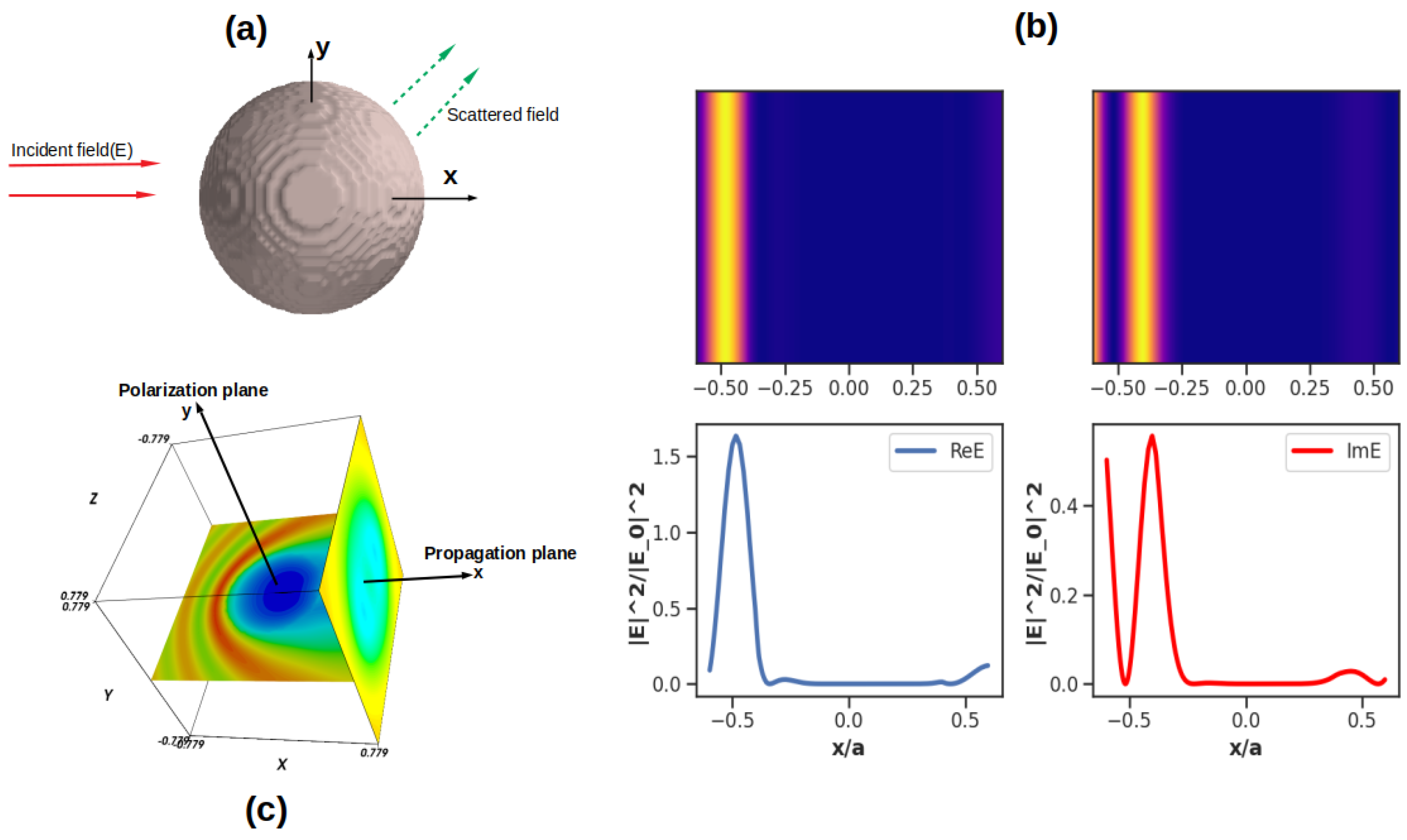
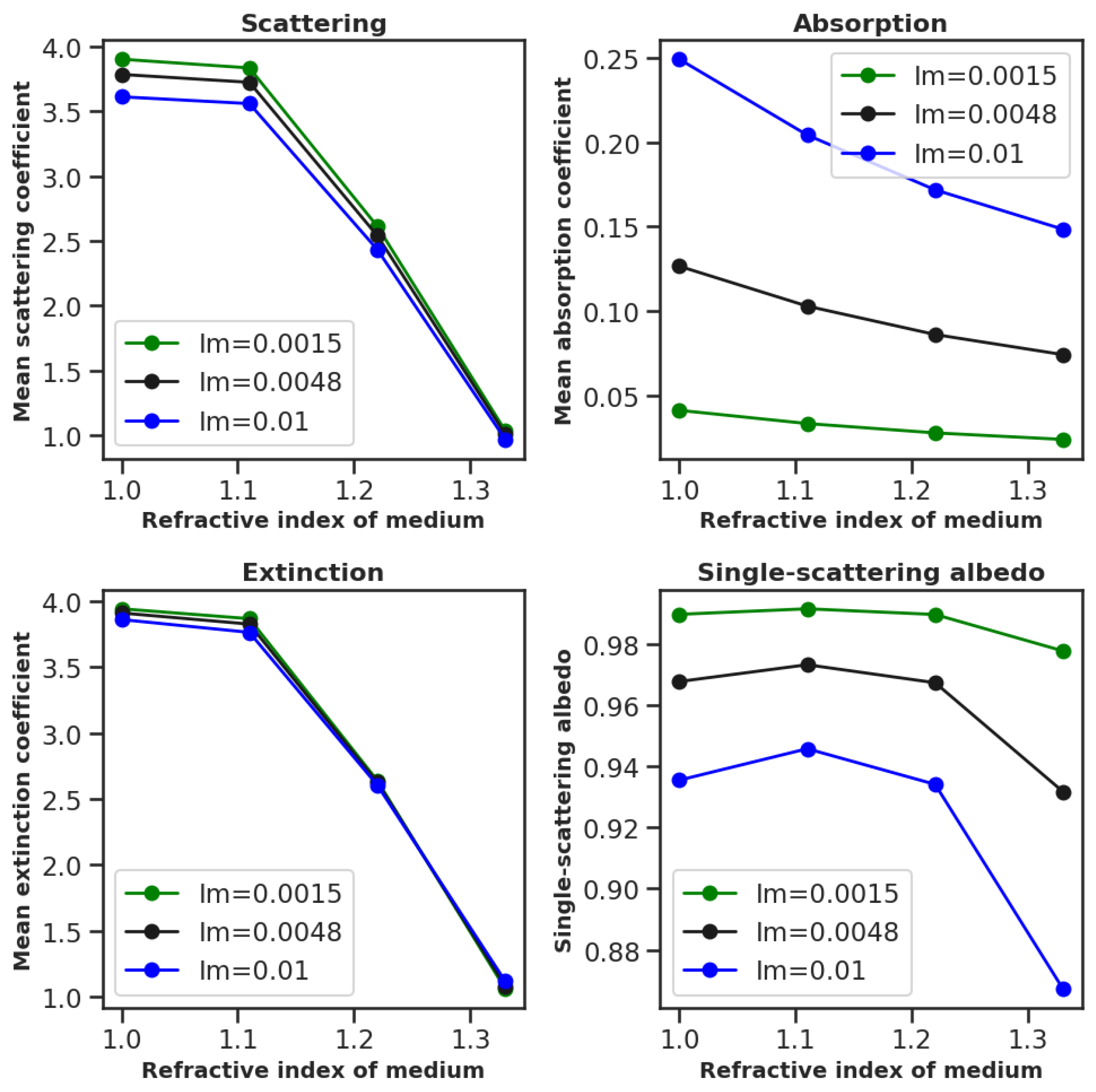
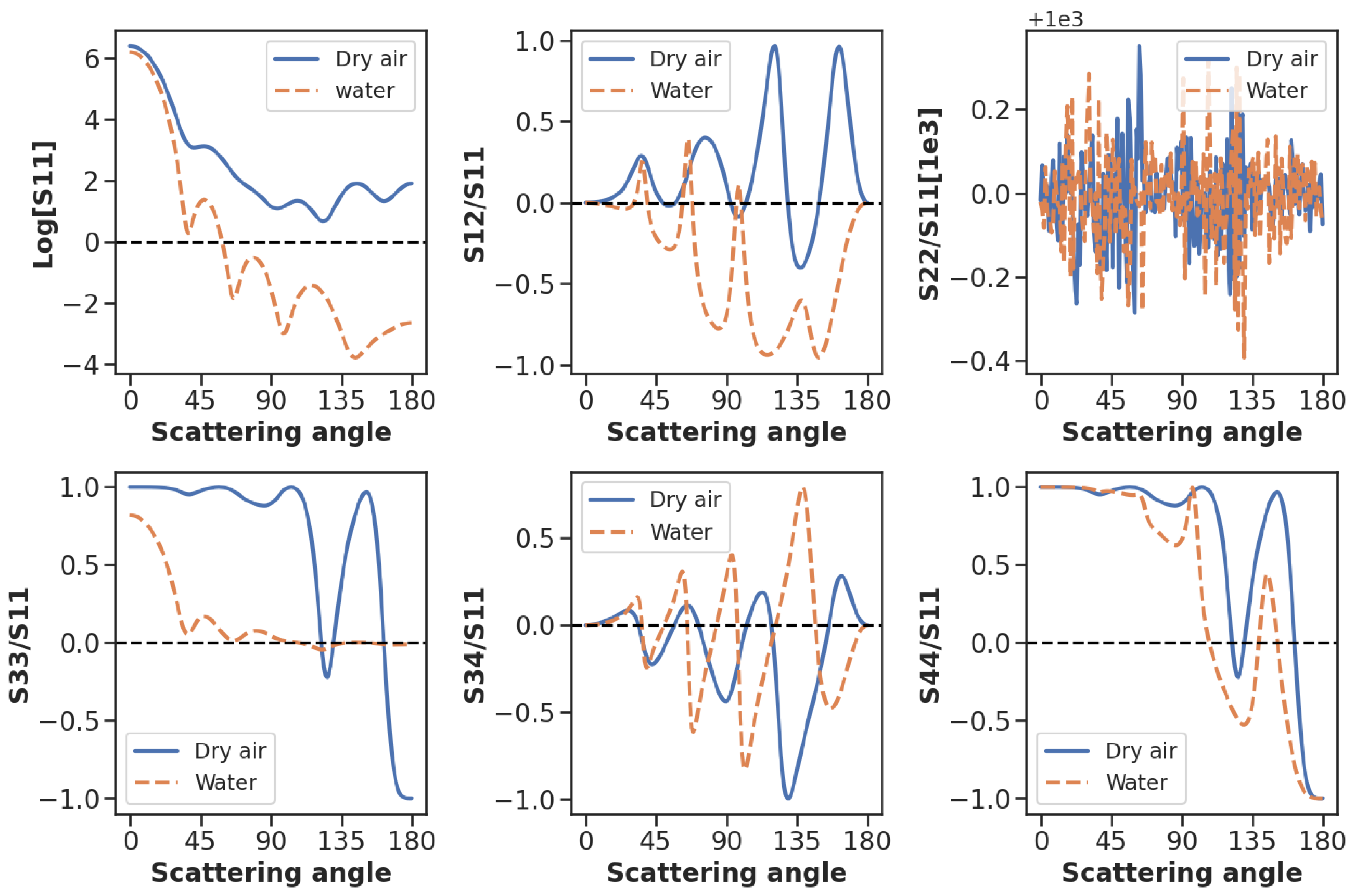
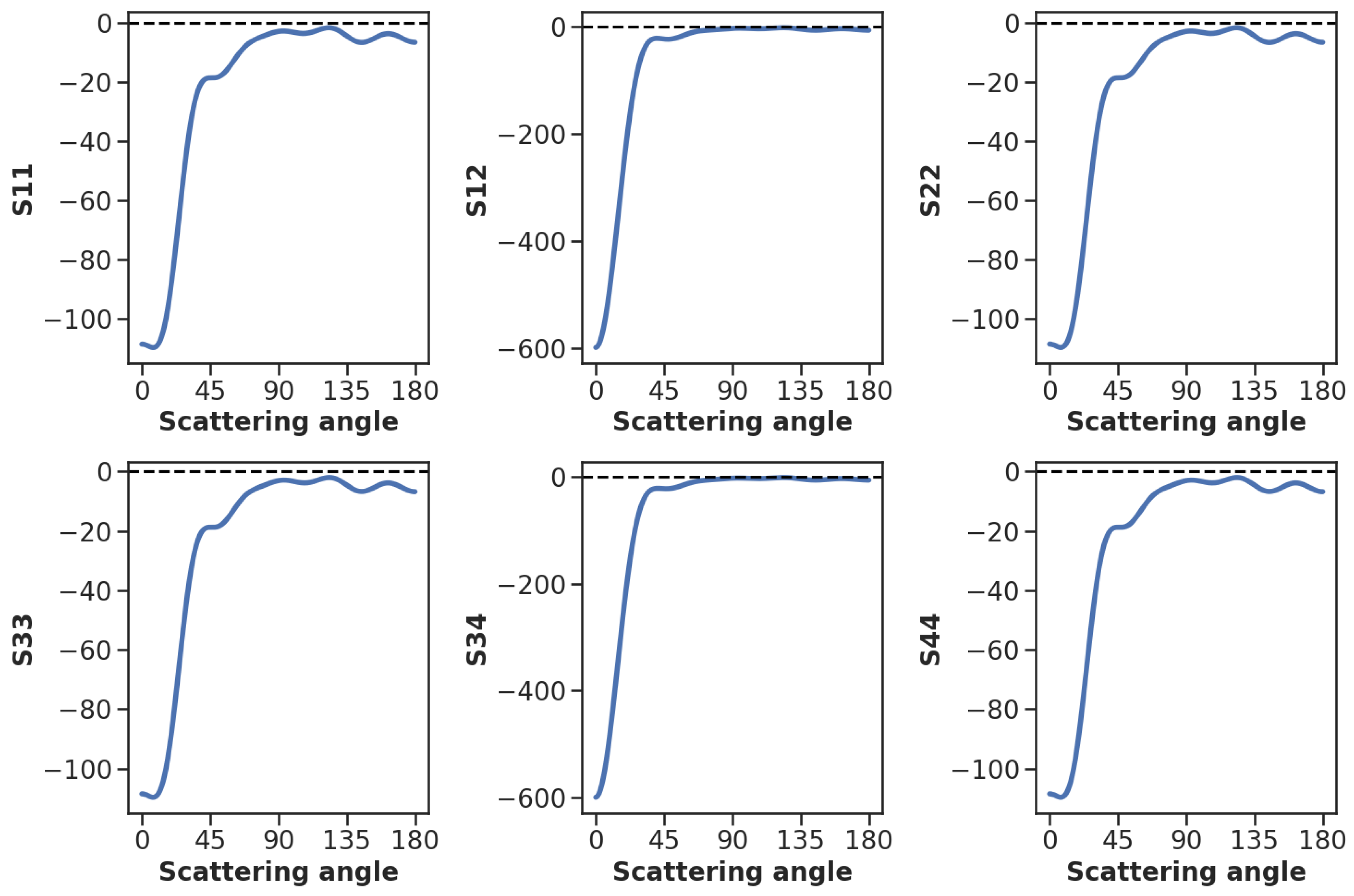
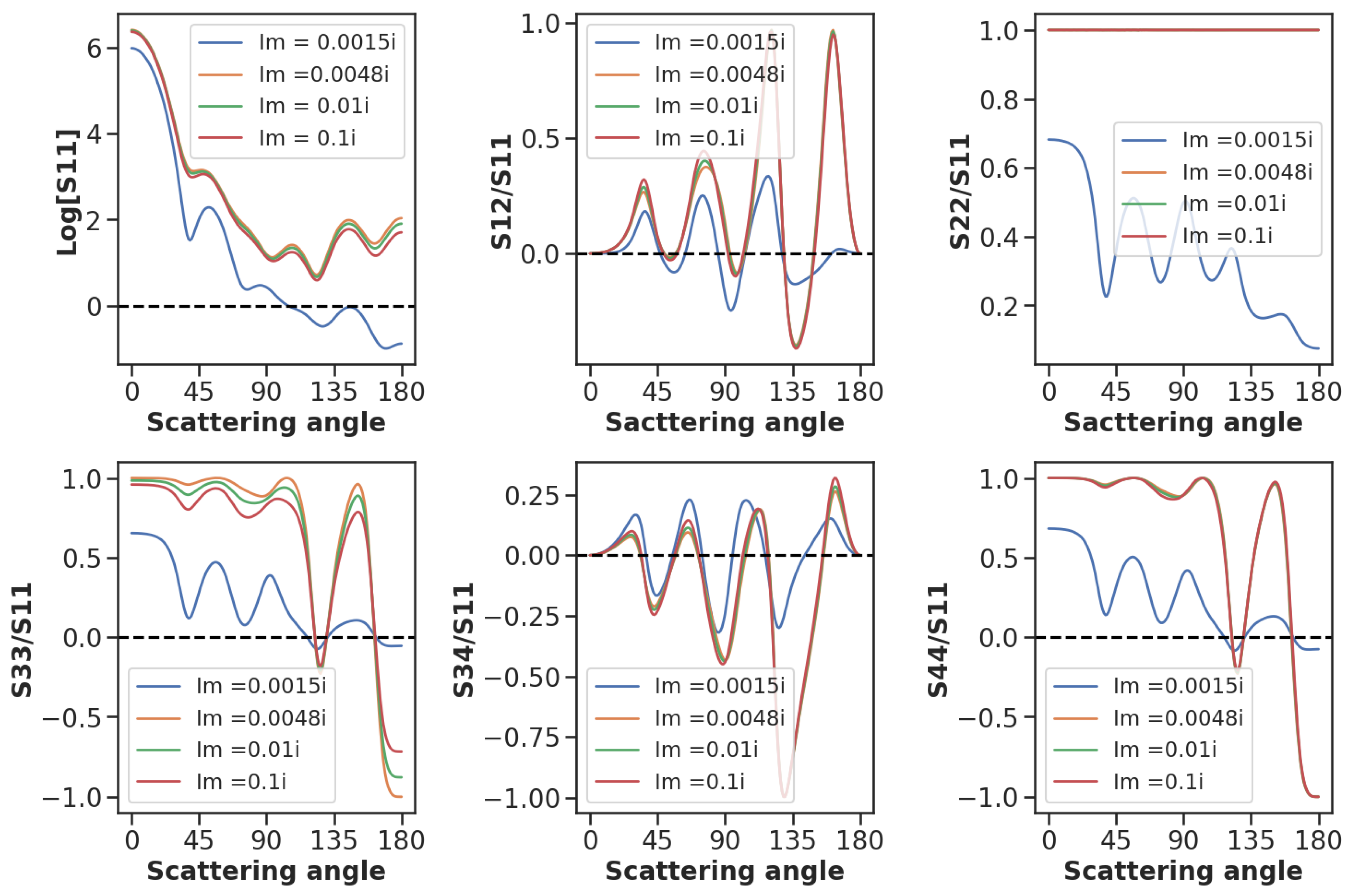
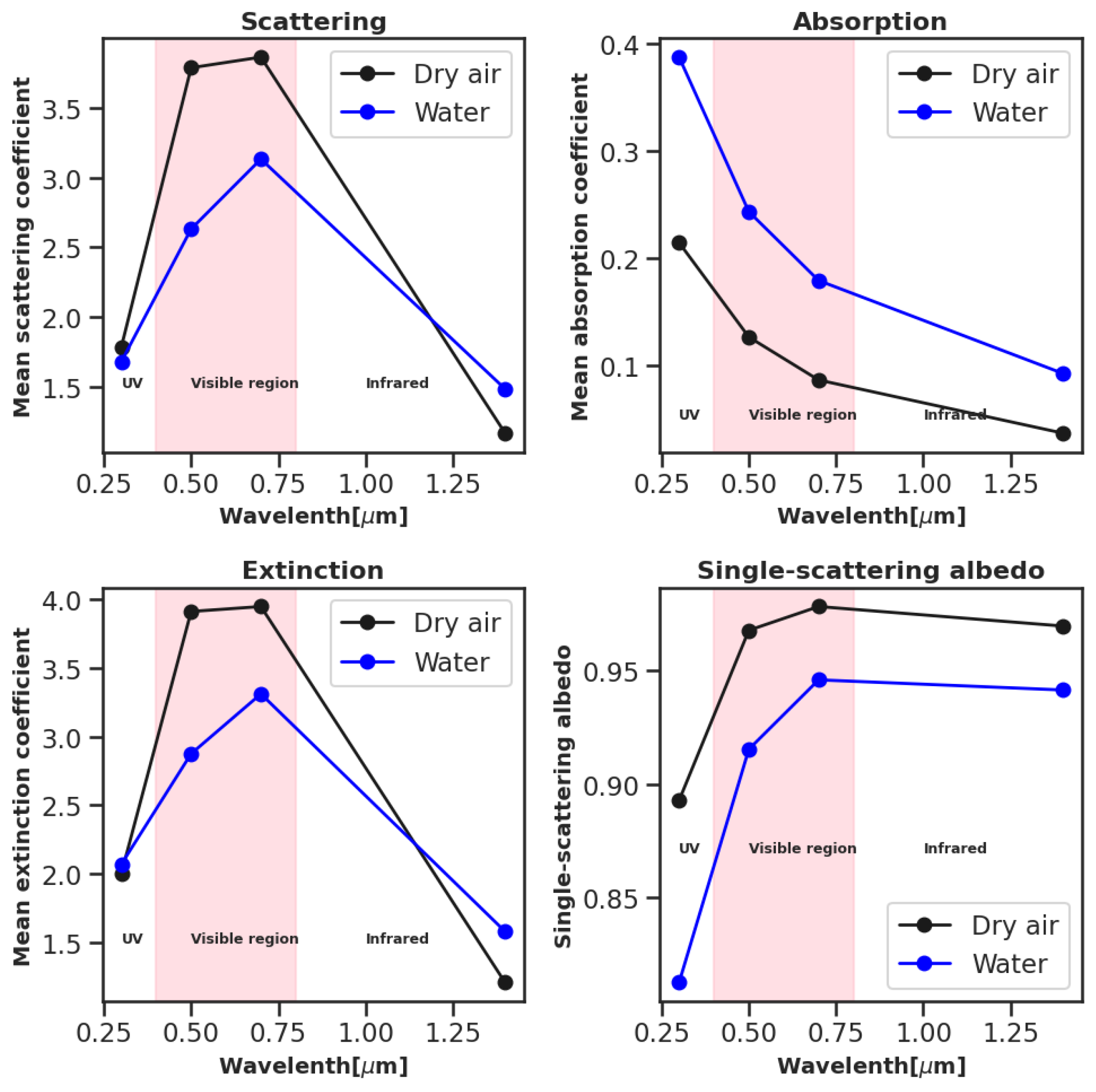
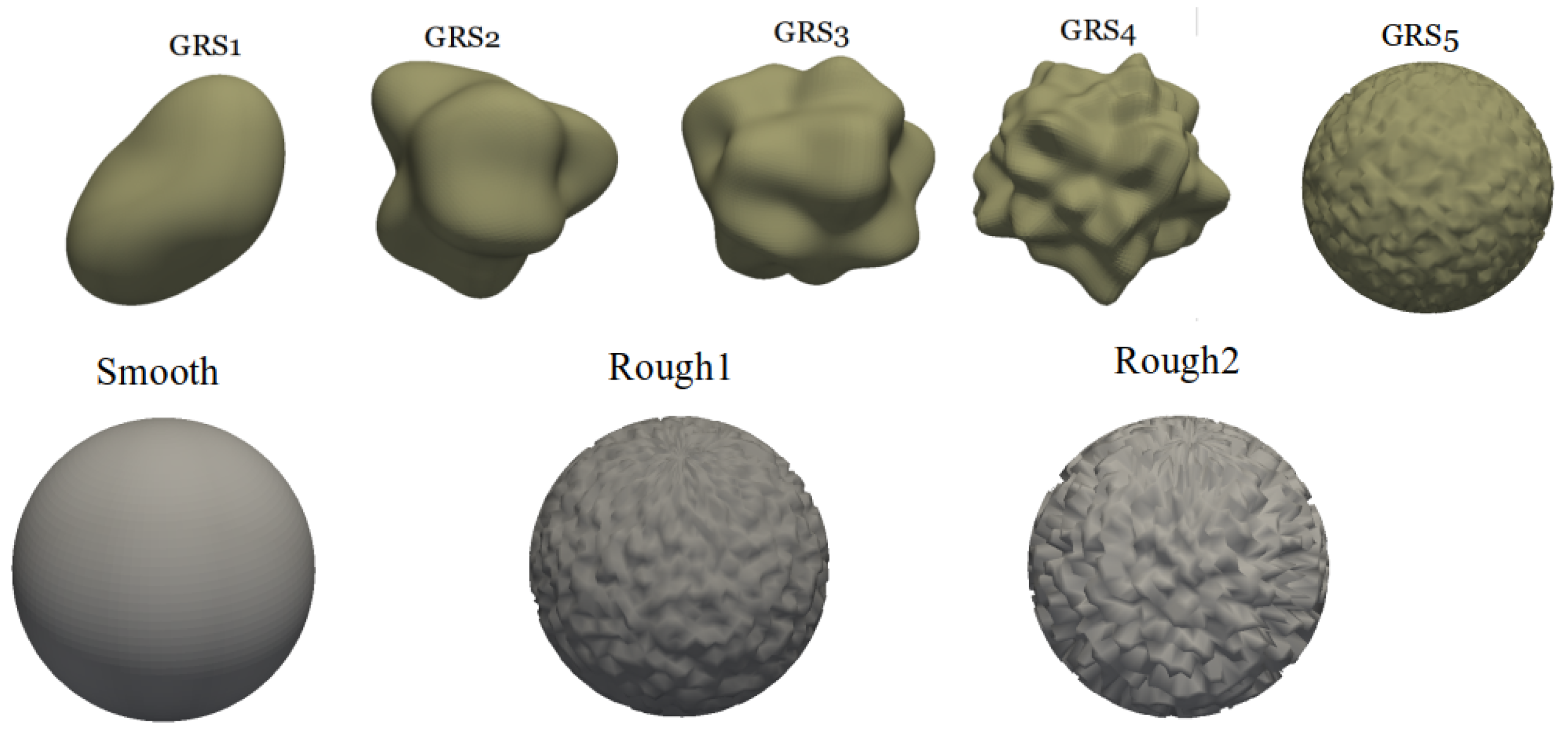
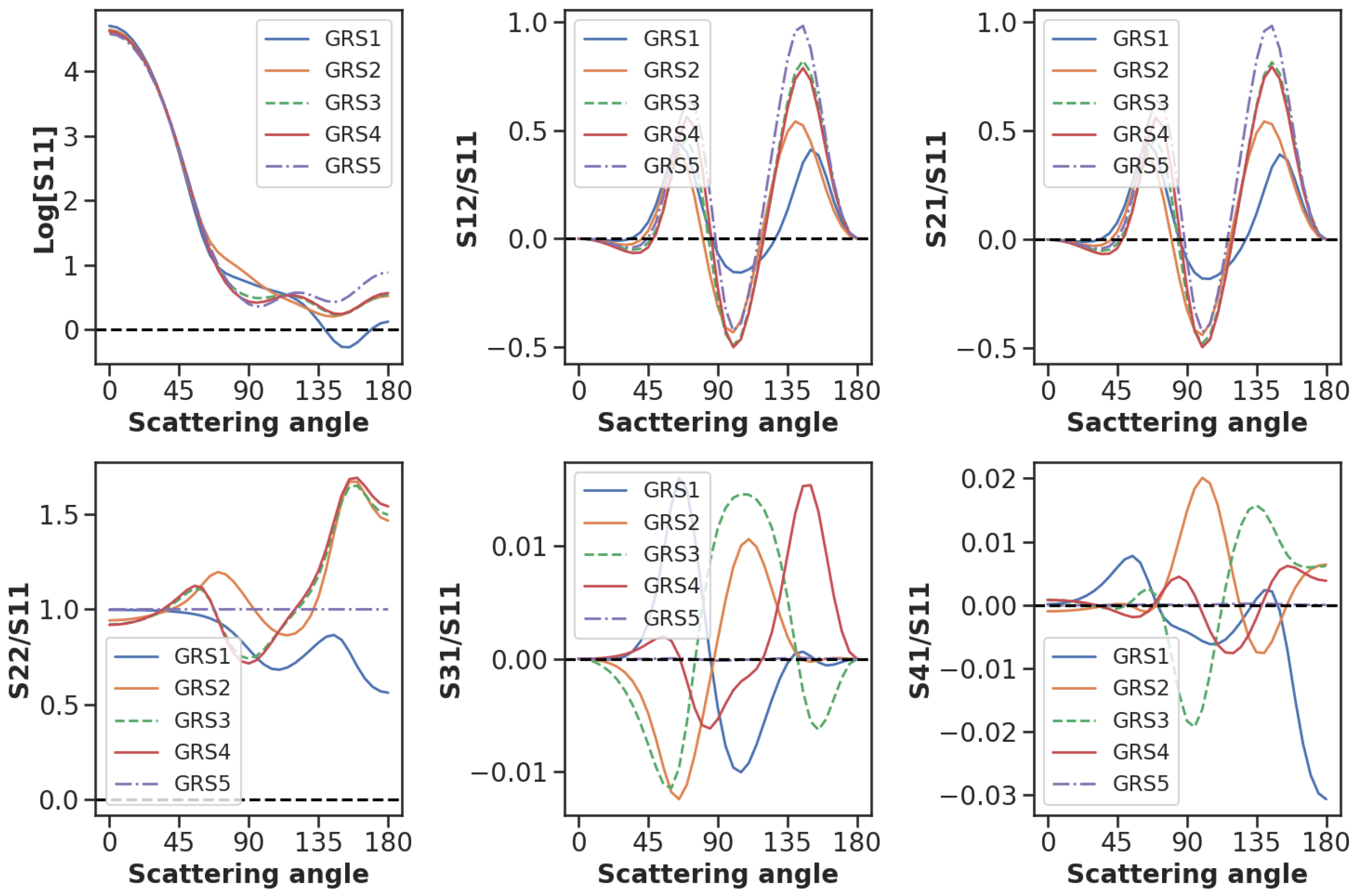

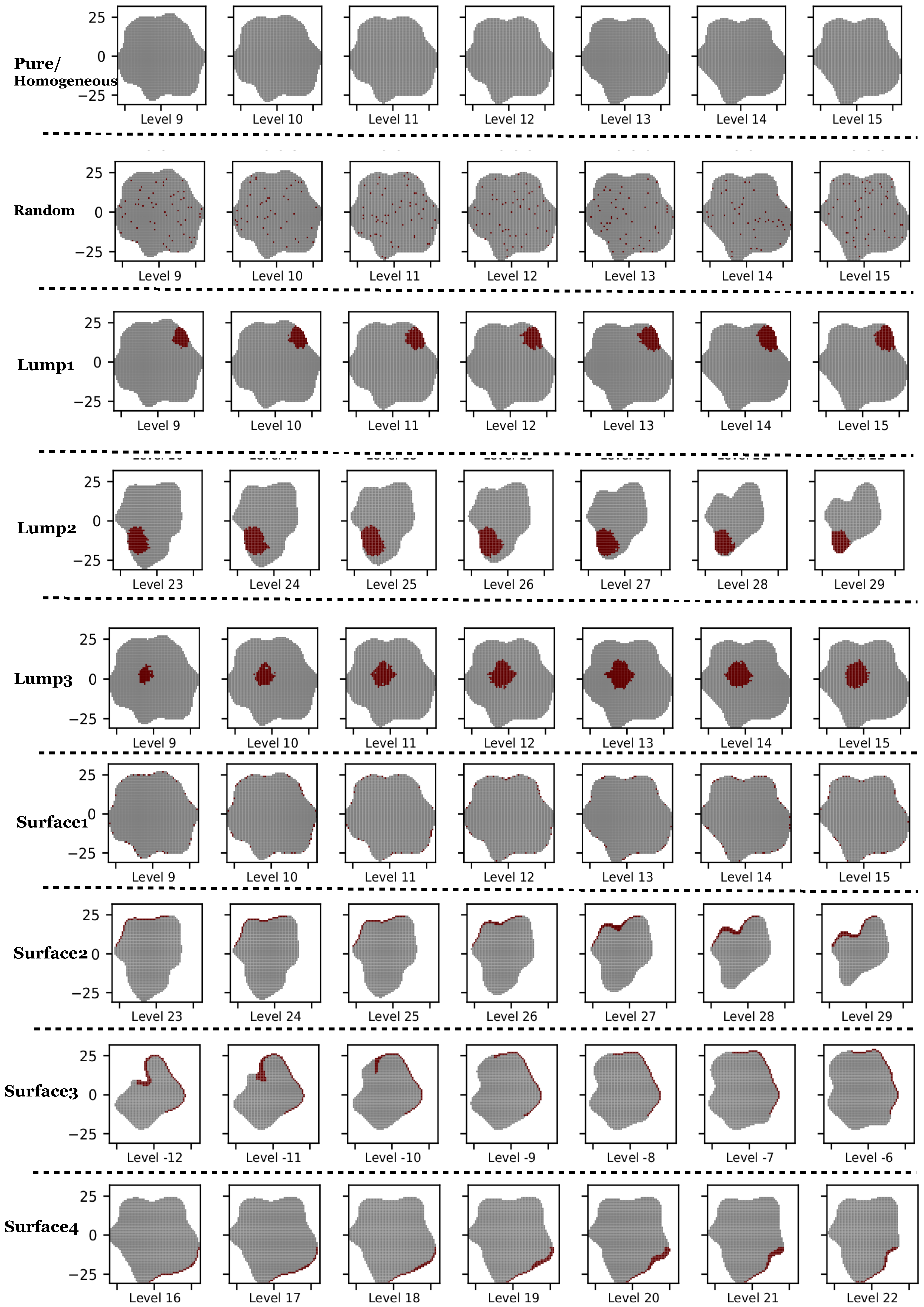
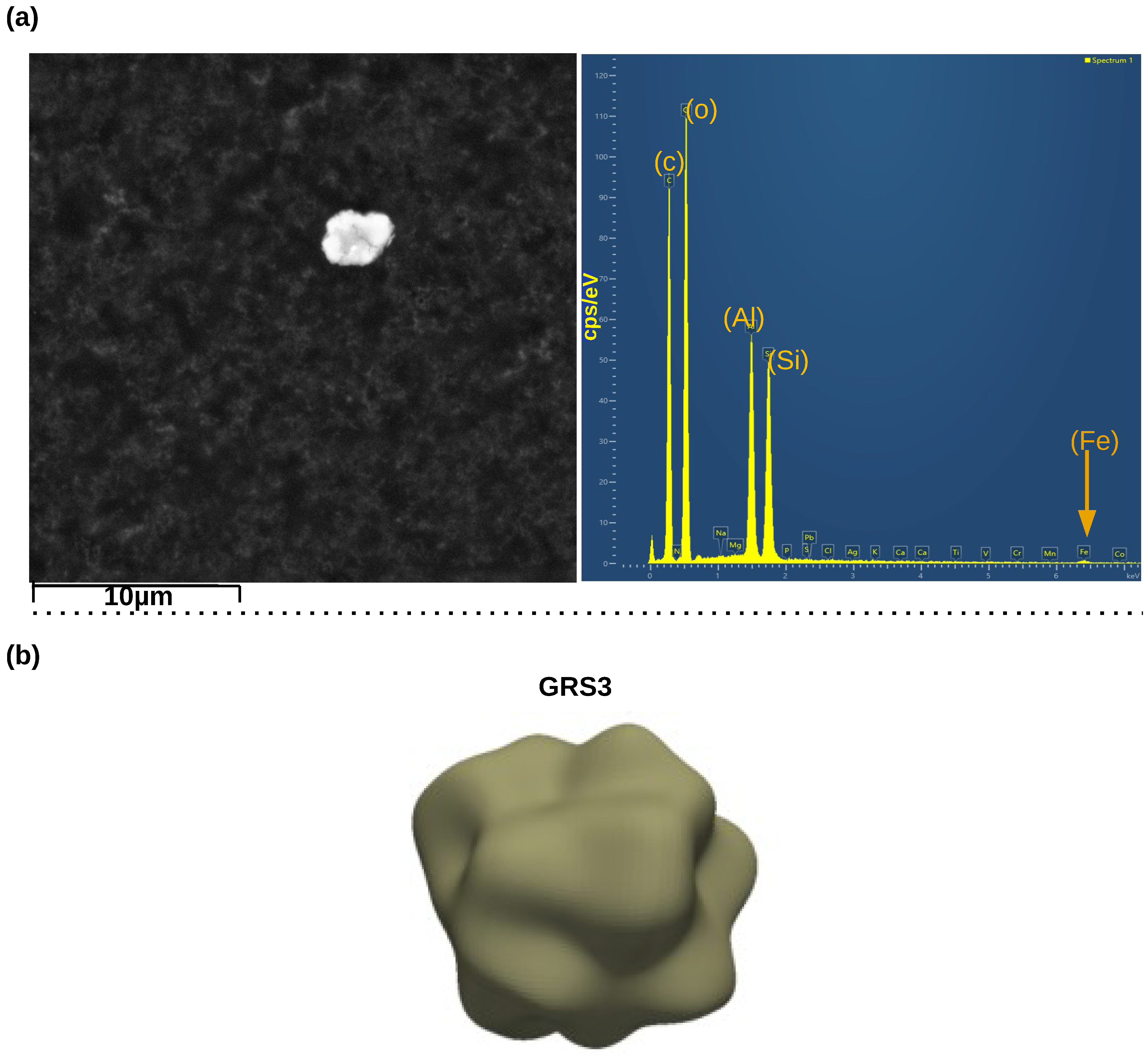
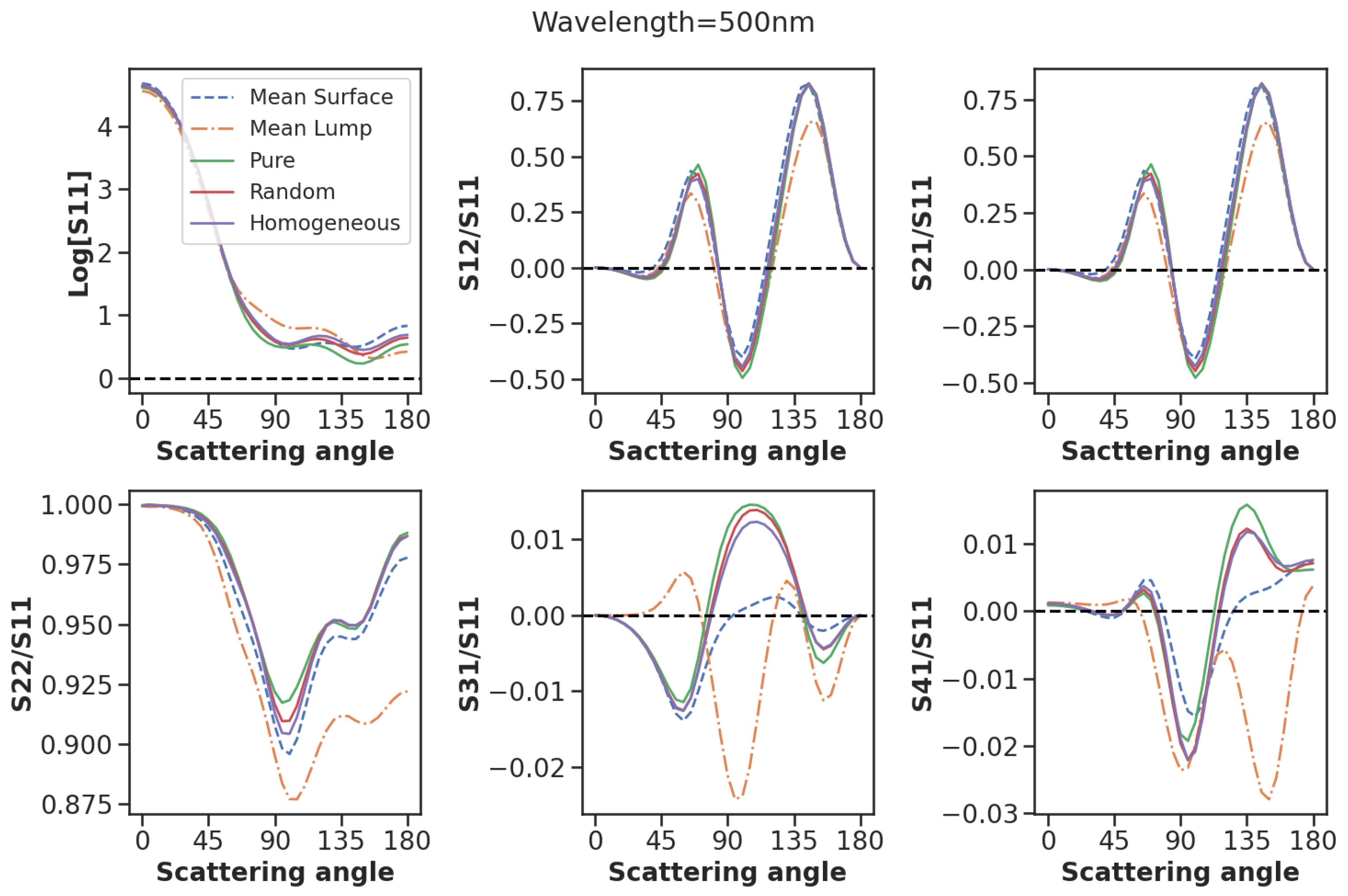
| Parameters | Models | (nm) | x | Medium | RI | |||||||
|---|---|---|---|---|---|---|---|---|---|---|---|---|
| Shape | GRS1 | 500 | 5 | air | 1.562 + 0.00i | 3.967 | 2.46 | 3.967 | ∼1 | 1.128 | 0.63 | 0.028 |
| GRS2 | 500 | 5 | air | 1.562 + 0.00i | 3.912 | −2.0 | 3.9137 | ∼1 | 1.678 | 1.654 | 0.0072 | |
| GRS3 | 500 | 5 | air | 1.562 + 0.00i | 3.852 | 5.577 | 3.852 | ∼1 | 1.709 | 1.689 | 0.0059 | |
| GRS4 | 500 | 5 | air | 1.562 + 0.00i | 3.853 | 6.02 | 3.853 | ∼1 | 1.755 | 1.739 | 0.0046 | |
| GRS5 | 500 | 5 | air | 1.562 + 0.00i | 3.8067 | 2.462 | 3.8068 | ∼1 | 2.416 | 2.416 | 0.00 | |
| Size parameter (x) | Sphere | 500 | 5.0 | air | 1.48 + 0.0048i | 3.192 | 1.176 | 2.016 | 0.632 | 0.414 | 0.414 | 0.0 |
| 500 | 17.6 | air | 1.48 + 0.0048i | 2.301 | 1.132 | 1.169 | 0.51 | 2.247 | 2.247 | 0.0 | ||
| Surface | Smooth | 500 | 5 | air | 1.48 + 0.0048i | 3.2995 | 0.0677 | 3.2317 | 0.979 | 1.3209 | 1.321 | ∼0.0 |
| roughness | Rough1 | 500 | 5 | air | 1.48 + 0.0048i | 3.2995 | 0.0676 | 3.2319 | 0.979 | 1.2586 | 1.259 | ∼0.0 |
| Rough2 | 500 | 5 | air | 1.48 + 0.0048i | 3.2919 | 0.0672 | 3.2247 | 0.979 | 1.0137 | 1.013 | ∼0.0 | |
| Wavelength | Sphere | 300 | 5 | air | 1.48 + 0.0048i | 2.0 | 0.214 | 1.78 | 0.89 | 5.33 | 5.33 | 0.0 |
| Sphere | 500 | 5 | air | 1.48 + 0.0048i | 3.91 | 0.12 | 3.78 | 0.967 | 6.73 | 6.73 | 0.0 | |
| Sphere | 700 | 5 | air | 1.48 + 0.0048i | 3.95 | 0.086 | 3.86 | 0.977 | 1.96 | 1.96 | 0.0 | |
| Sphere | 1400 | 5 | air | 1.48 + 0.0048i | 1.21 | 0.037 | 1.17 | 0.967 | 0.04 | 0.04 | 0.0 | |
| Ambient | Sphere | 500 | 5 | air | 1.48 + 0.0048i | 3.91 | 0.13 | 3.78 | 0.967 | 6.74 | 6.74 | 0.0 |
| Sphere | 500 | 5 | water | 1.48 + 0.0048i | 1.08 | 0.074 | 1.01 | 0.93 | 0.0713 | 0.0713 | 0.0 | |
| Particle | Sphere | 500 | 5 | air | 1.48 + 0.0015i | 3.943 | 0.041 | 3.902 | 0.989 | 7.658 | 7.658 | 0.0 |
| Im (RI) | Sphere | 500 | 5 | air | 1.48 + 0.0048i | 3.911 | 0.13 | 3.784 | 0.967 | 6.738 | 6.738 | 0.0 |
| Sphere | 500 | 5 | air | 1.48 + 0.01i | 3.862 | 0.25 | 3.612 | 0.935 | 5.508 | 5.508 | 0.0 | |
| Sphere | 500 | 5 | air | 1.48 + 0.1i | 3.192 | 1.176 | 2.016 | 0.631 | 0.414 | 0.414 | 0.0 |
| Parameters | Models | |||||||
|---|---|---|---|---|---|---|---|---|
| Composition | Pure kaolinite | 4.239 | −5.95 | 4.239 | 1 | 4.118 | 3.95 | 0.021 |
| ( = 380 nm) | Random | 4.228 | 0.019 | 4.209 | 0.995 | 4.85 | 4.635 | 0.023 |
| Homogeneous | 4,23 | 0.023 | 4.21 | 0.995 | 5.154 | 4.924 | 0.023 | |
| Surface (mean ± std) | 4.343 (0.015) | 0.052 (0.005) | 4.289 (0.012) | 0.987 (0.833) | 6.667 (0.001) | 6.327 (0.783) | 0.026 (0.007) | |
| Lump (mean ± std) | 3.962 (0.160) | 0.078 (0.011) | 3.885 (0.168) | 0.980 (0.003) | 3.771 (0.407) | 2.796 (0.555) | 0.015 (0.117) | |
| Composition | Pure kaolinite | 3.852 | 5.577 | 3.852 | 1 | 1.709 | 1.689 | 0.0059 |
| ( = 500 nm) | Random | 3.956 | 0.012 | 3.944 | 0.997 | 1.895 | 1.87 | 0.0053 |
| Homogeneous | 4.01 | 0.015 | 3.997 | 0.997 | 1.98 | 1.95 | 0.0076 | |
| Surface (mean ± std) | 4.033 (0.006) | 0.031 (0.002) | 3.998 (0.002) | 0.991 (0.001) | 2.29 (0.168) | 2.239 (0.161) | 0.011 (0.002) | |
| Lump (mean ± std) | 3.838 (0.277) | 0.062 (0.008) | 3.775 (0.279) | 0.983 (0.003) | 1.517 (0.223) | 1.398 (0.166) | 0.039 (0.027) | |
| Composition | Pure kaolinite | 2.768 | 1.288 | 2.768 | 1 | 0.77 | 0.763 | 0.00022 |
| ( = 650 nm) | Random | 2.934 | 0.0086 | 2.926 | 0.997 | 0.752 | 0.75 | 0.0027 |
| Homogeneous | 3.02 | 0.011 | 3.01 | 0.997 | 0.75 | 0.75 | 0.0033 | |
| Surface (mean ± std) | 2.977 (0.006) | 0.021 (0.002) | 2.957 (0.006) | 0.993 (0.0) | 0.662 (0.009) | 0.654 (0.011) | 0.0065 (0.001) | |
| Lump (mean ± std) | 3.021 (0.033) | 0.027 (0.007) | 2.993 (0.026) | 0.991 (0.002) | 0.67 (0.18) | 0.66 (0.178) | 0.0069 (0.004) |
Disclaimer/Publisher’s Note: The statements, opinions and data contained in all publications are solely those of the individual author(s) and contributor(s) and not of MDPI and/or the editor(s). MDPI and/or the editor(s) disclaim responsibility for any injury to people or property resulting from any ideas, methods, instructions or products referred to in the content. |
© 2023 by the authors. Licensee MDPI, Basel, Switzerland. This article is an open access article distributed under the terms and conditions of the Creative Commons Attribution (CC BY) license (https://creativecommons.org/licenses/by/4.0/).
Share and Cite
Arreyndip, N.A.; Kandler, K.; Sudharaj, A. Near-Field Single-Scattering Calculations of Aerosols: Sensitivity Studies. Optics 2023, 4, 375-395. https://doi.org/10.3390/opt4020028
Arreyndip NA, Kandler K, Sudharaj A. Near-Field Single-Scattering Calculations of Aerosols: Sensitivity Studies. Optics. 2023; 4(2):375-395. https://doi.org/10.3390/opt4020028
Chicago/Turabian StyleArreyndip, Nkongho Ayuketang, Konrad Kandler, and Aryasree Sudharaj. 2023. "Near-Field Single-Scattering Calculations of Aerosols: Sensitivity Studies" Optics 4, no. 2: 375-395. https://doi.org/10.3390/opt4020028
APA StyleArreyndip, N. A., Kandler, K., & Sudharaj, A. (2023). Near-Field Single-Scattering Calculations of Aerosols: Sensitivity Studies. Optics, 4(2), 375-395. https://doi.org/10.3390/opt4020028






